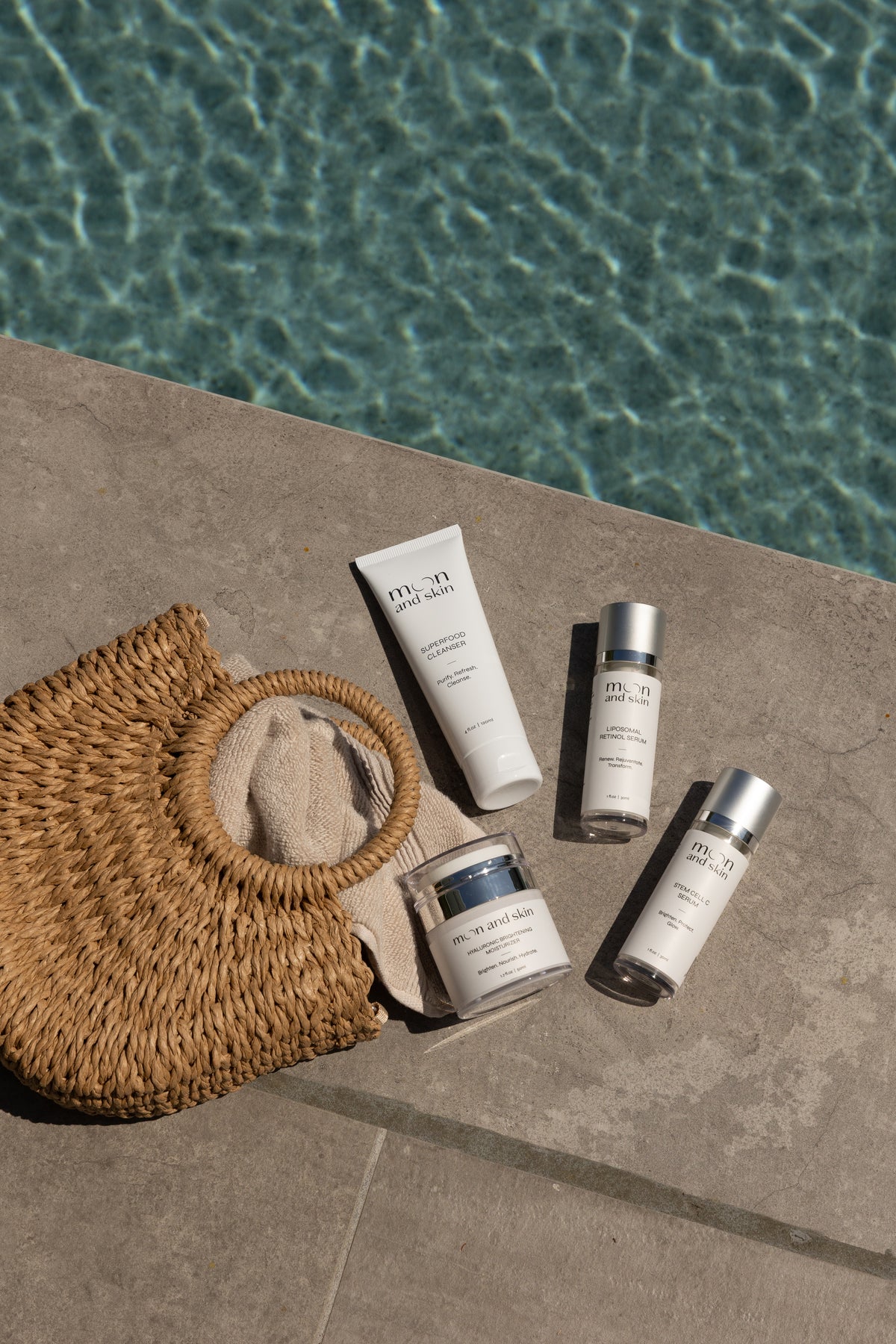Table of Contents
Introduction
Did you know that our skin is the largest organ in our body and serves as a protective barrier against environmental factors? Yet, despite its importance, many of us struggle to find the right skincare routine that suits our unique skin needs. We understand that navigating the world of skincare can often feel overwhelming, especially with the vast array of products available and the varied advice floating around.
The journey to healthy, radiant skin begins with understanding your skin type, recognizing its specific needs, and selecting products that align with those needs. Whether you're battling dryness, excess oil, or sensitivity, developing an effective skincare routine is essential for maintaining a healthy complexion.
In this blog post, we will explore how to find the right skincare routine tailored to your skin type and concerns. We'll cover everything from identifying your skin type to understanding the importance of each step in a skincare regimen. Together, we’ll simplify the process so that you can feel empowered and confident in your skincare choices.
Understanding Your Skin Type
The first step in establishing an effective skincare routine is to identify your skin type. Understanding your skin's unique characteristics will guide you in choosing the most suitable products. There are generally five skin types:
- Normal Skin: Balanced and not too oily or dry, normal skin typically has a smooth texture and minimal imperfections.
- Dry Skin: This skin type may feel tight, show flakiness, and is often prone to irritation. Dry skin lacks moisture and may require richer products to hydrate.
- Oily Skin: Characterized by a shiny appearance and enlarged pores, oily skin is prone to acne and blemishes due to excess sebum production.
- Combination Skin: This skin type exhibits characteristics of both oily and dry skin, often being oily in the T-zone (forehead, nose, chin) while remaining dry on the cheeks.
- Sensitive Skin: Easily irritated, sensitive skin may react negatively to products, resulting in redness, burning, or stinging sensations.
To help you identify your skin type, consider conducting a simple test: cleanse your face and wait for about an hour without applying any products. Observe how your skin feels—tightness indicates dryness, while shine suggests oiliness. Combination skin will show both characteristics, and normal skin will feel comfortable without any extreme sensations.
Key Takeaways
- Identifying your skin type is crucial for selecting the right products.
- Each skin type has unique characteristics that require specific care.
- A simple test can help you determine your skin type effectively.
Understanding Your Skin Concerns
Once you’ve identified your skin type, the next step is to understand your skin concerns. These concerns can vary widely and may include:
- Acne and Blemishes: Commonly associated with oily skin, acne can occur due to clogged pores, excess oil, and bacteria.
- Fine Lines and Wrinkles: Typically a concern for aging skin, fine lines and wrinkles may require targeted treatments to improve skin texture.
- Hyperpigmentation: Dark spots caused by sun exposure or hormonal changes can often be addressed with specific ingredients.
- Dullness: Lackluster skin may indicate a need for exfoliation and hydration.
- Dehydration: Dry skin may require richer moisturizers and hydrating serums.
Understanding these concerns will help you select products formulated with effective ingredients. For instance, those with acne-prone skin may benefit from products containing salicylic acid or benzoyl peroxide, while those focusing on anti-aging might look for retinol or peptides.
Key Takeaways
- Recognizing specific skin concerns helps in selecting targeted treatments.
- Different concerns require different active ingredients for effective management.
Building Your Basic Skincare Routine
Now that you know your skin type and concerns, it's time to build a basic skincare routine. A well-rounded routine typically includes the following steps:
1. Cleansing
Cleansing is the foundation of any good skincare routine. It removes dirt, oil, and impurities from your skin. Choose a cleanser that suits your skin type:
- For Normal/Combination Skin: A gentle foaming cleanser can effectively cleanse without stripping moisture.
- For Dry Skin: Look for a hydrating cream or oil-based cleanser that won't dry out your skin.
- For Oily Skin: An oil-free foaming cleanser will help remove excess oil and prevent breakouts.
- For Sensitive Skin: Opt for a fragrance-free, soothing cleanser with calming ingredients like aloe or chamomile.
At Moon and Skin, our Superfood Cleanser is formulated with HydroProtein Technology to gently cleanse while deeply nourishing your skin.
2. Moisturizing
Moisturizing is crucial for maintaining hydration and barrier function in your skin. Even oily skin needs moisture, but the key is to choose the right formulation:
- For Normal Skin: A lightweight, non-comedogenic moisturizer works well.
- For Dry Skin: Look for richer creams that offer deep hydration.
- For Oily Skin: A gel-based, oil-free moisturizer can provide hydration without clogging pores.
- For Sensitive Skin: Choose a moisturizer with soothing ingredients to minimize irritation.
Our Hyaluronic Brightening Moisturizer is perfect for all skin types, offering both hydration and brightening benefits.
3. Sun Protection
The importance of sun protection cannot be overstated. Daily use of a broad-spectrum sunscreen with at least SPF 30 is essential for preventing premature aging and protecting against skin cancer. Be sure to reapply every two hours if you're outdoors.
4. Exfoliation
Exfoliating helps remove dead skin cells, improving texture and promoting a radiant complexion. However, the frequency and method depend on your skin type:
- For Oily Skin: You might benefit from exfoliating 2-3 times a week with chemical exfoliants like salicylic acid.
- For Dry/Sensitive Skin: Limit exfoliation to once a week and choose gentle formulas.
5. Targeted Treatments
After establishing the basics, consider integrating targeted treatments based on your specific skin concerns. This could include serums for brightening, acne treatments, or anti-aging products.
Our Stem Cell C Serum is a fantastic option for brightening and protecting your skin, thanks to its advanced plant-cell technology and stable vitamin C.
Key Takeaways
- A basic skincare routine includes cleansing, moisturizing, sun protection, and exfoliation.
- Customize your routine based on your skin type and specific needs.
- Incorporate targeted treatments for enhanced results.
Patch Testing New Products
Before introducing new products into your routine, it's essential to conduct a patch test. This involves applying a small amount of the product on a discreet area of skin (like your wrist) and observing for any adverse reactions over 24-48 hours. This step is particularly important for those with sensitive skin or allergies.
Key Takeaways
- Always patch test new products to avoid potential reactions.
- Apply a small amount on a discreet area before full application.
Consistency is Key
One of the biggest mistakes we often make in skincare is expecting instant results. Skincare is a long-term commitment, and consistency is crucial. Stick to your routine for at least 4-6 weeks before evaluating the results. This allows your skin to adjust to the products and show noticeable improvement.
Key Takeaways
- Consistency in your skincare routine is essential for achieving desired results.
- Be patient; it may take weeks to see significant changes.
Consulting a Dermatologist
If you’re unsure about your skin type, or if you’re dealing with persistent concerns like severe acne or eczema, consulting a dermatologist is always a wise choice. They can provide professional advice tailored to your specific needs and recommend suitable products that align with your skincare goals.
Key Takeaways
- Consulting a dermatologist can offer personalized guidance for your skin concerns.
- Professional evaluations can help you choose the right treatments and products.
Conclusion
Finding the right skincare routine may seem daunting, but with a clear understanding of your skin type and concerns, you can establish a regimen that supports your skin's health and beauty. By incorporating gentle and effective products, like our Best Sellers collection, including the Liposomal Retinol Serum and Hyaluronic Brightening Moisturizer, you're well on your way to achieving the radiant skin you desire.
Remember, skincare is a journey—embrace it! So why not take the first step today? Explore our Bundle & Save collection to build a full routine that empowers your skin at every phase of life.
FAQ
1. How long does it take to see results from my skincare routine?
Results can vary, but typically you should give your skin at least 4-6 weeks to adjust to new products before assessing effectiveness.
2. How do I know if a product is right for my skin?
Understanding your skin type and concerns is key. Always read labels and look for ingredients that specifically target your needs.
3. Can I use multiple products at once?
Yes, but be cautious about layering too many products. Start with a simple routine and slowly introduce additional products based on your skin's response.
4. What should I do if I experience irritation from a product?
Stop using the product immediately and consult with a dermatologist if irritation persists.
5. Is it necessary to use sunscreen every day?
Absolutely! Daily sun protection is crucial for preventing skin damage and signs of aging.







